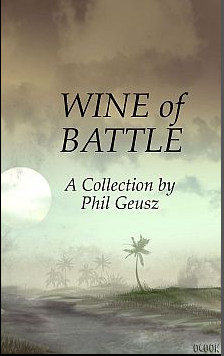Author: Phil Geusz.
Publisher: Legion Publishing
ISBN10: none
ISBN13: 978-0-9829866-2-2
“Nobody ever comes back from war the same…
But some transformations are more obvious than others.
Wine of Battle is a collection of short stories dealing with transformation in times of war and conflict, from the ancient past through the civil war and far into the future.” (publisher’s blurb)
These nine stories are Phil Geusz’s first collection of short stories. They are transformation tales; grim science-fiction or fantasy horror stories about protagonists who have already faced the horrors of warfare, only to add to them the terror of becoming – something else. The above publisher’s blurb is slightly misleading: sometimes the protagonists do not come back home …
“A High Tech Spear” is a s-f story about war in the near future. Earth is invaded by aliens, and USAF Captain Walter Duomonte is one of the fighter pilots trying to prevent them gaining a foothold in the Ozark Mountains. After he barely survives a suicide-dive into an alien ship, in which he is left horribly crippled, he is asked to volunteer for a process that will duplicate his mind into an inhuman but even more efficient fighting machine against the invaders. Which of the two is the real Walter Duomonte, he wonders.
“Cold Judgment” is a Civil War fantasy. Cletus, a naïve teenage farm boy riding with Quantrill’s Raiders in Missouri, is sickened by the brutality of guerrilla warfare against civilians and slaves, but it is after encountering African-American sorcery that he flees the Raiders to fight the rest of the war more honorably.
“Wine of Battle” takes place during the Vietnam War. Jonesy is a soldier on a resupply convoy headed for a forward base deep in VC territory. Everyone knows that many of the troops were heavily into drugs, and when Jonesy is given what he is told is some extra-good new stuff, he takes it just before his convoy is enveloped in a surprise attack. Jonesy turns into a tripped-out monster that wipes out the VC single-handedly, but how much of what happened was a psychedelic daze and how much was a real transformation?
“Darkness Stood Alone” is a short mood-piece set in mankind’s Stone Age past. A shaman has cast a spell to make his tribe’s greatest warrior an invulnerable killer. Then he is overwhelmed by a numerically greater enemy. What can they do with him?
“Blasphemy at Phuc-Too Ridge” is another Vietnam War story – well, no; it just seems like one at first. It is the far future, on the Vietnam-like planet Mangrove, and Lieutenant Craig Rushton has been bioengineered into a slothlike “furball” native to infiltrate the jungle-living locals and sabotage the “Badgers” who are fighting against the human occupation of their world. If this sounds like a plot-summary of the movie Avatar, the story is quite different.
“Pig Boat” takes place soon after America’s entry into World War II, aboard one of the S-class “pigboat” U.S. Navy submarines that were so woefully inferior to the Imperial Japanese Navy’s. The S-52 is opposing the Imperial Navy’s occupation of Attu and Kiska Islands in the Aleutians, and gets into a deadly game of hide-and-seek with a Japanese destroyer, when – something – happens to both of them.
“Breaking the Chains”, at 111 pages almost a novel, is the only one that is not a war story. It is science-fiction, set in a future where animals have been bioengineered into semi-intelligence and an anthropomorphic form to serve as a slave-labor class; the workbunnies and lovekittens and farmhorses and guarddogs and so on. Jebediah Wright, the narrator, is a unique human who has let himself be bioengineered into “Numbskull”, an apparent worker-bunny who is really part of an elite team of industrial agents who infiltrate and uncover complex white-collar criminal activities. Jeb’s conversion into an anthropomorphized rabbit requires him to enter the society of workbunnies to pose as one of them, and he is appalled at their working conditions. Suddenly his real mission as an undercover agent seems less important to him than being an activist for bioengineered animals’ rights.
“Spirit Path” is another World War II story, this one on the European front and about aviators. After Singing Bear, a native American who is a B-17 bomber pilot, is the only survivor of two shot-up missions deep into Nazi territory, he gets the reputation of a jinx. The narrator, his co-pilot on a third mission, learns how he does it.
“Kaiten!!”, the last story, features Lt. Juro Kamome, a Japanese kamikaze-pilot in the last days of World War II. The kaiten were both the human volunteers who pledged their lives against the advancing American military, and a class of submarine torpedoes with a human pilot to ensure that they were guided to their objective. Juro, a pilot-trainee, hopes to become an aerial kamikaze and is disappointed to be assigned to one of the guided torpedoes instead. He achieves his life’s wish in an unexpected way.
Geusz has a knack for making the reader feel that he or she is there in the World War II and Vietnam stories; the military details are very convincing. Those set in the future are good s-f adventures. The stories are unfortunately practically all depressing, but that seems natural since most are built around a seemingly-hopeless battle. No story credits are given, but at least three of the nine appeared in on-line websites and magazines between 1997 and 2010. “Wine of Battle” features nine very readable s-f stories that readers are unlikely to find anywhere else.
Disclosure: A free copy of this book was furnished by the publisher for review, but providing a copy did not guarantee a review. This information is provided per the regulations of the Federal Trade Commission. Thoughts and opinions are that of the reviewer.






